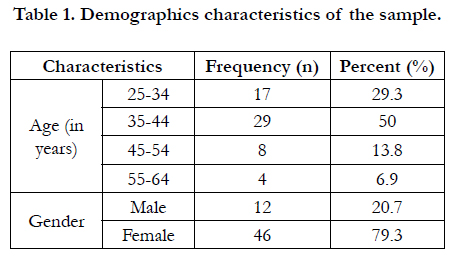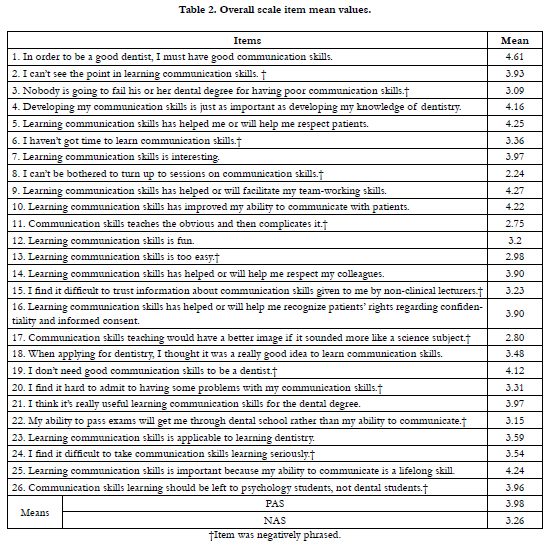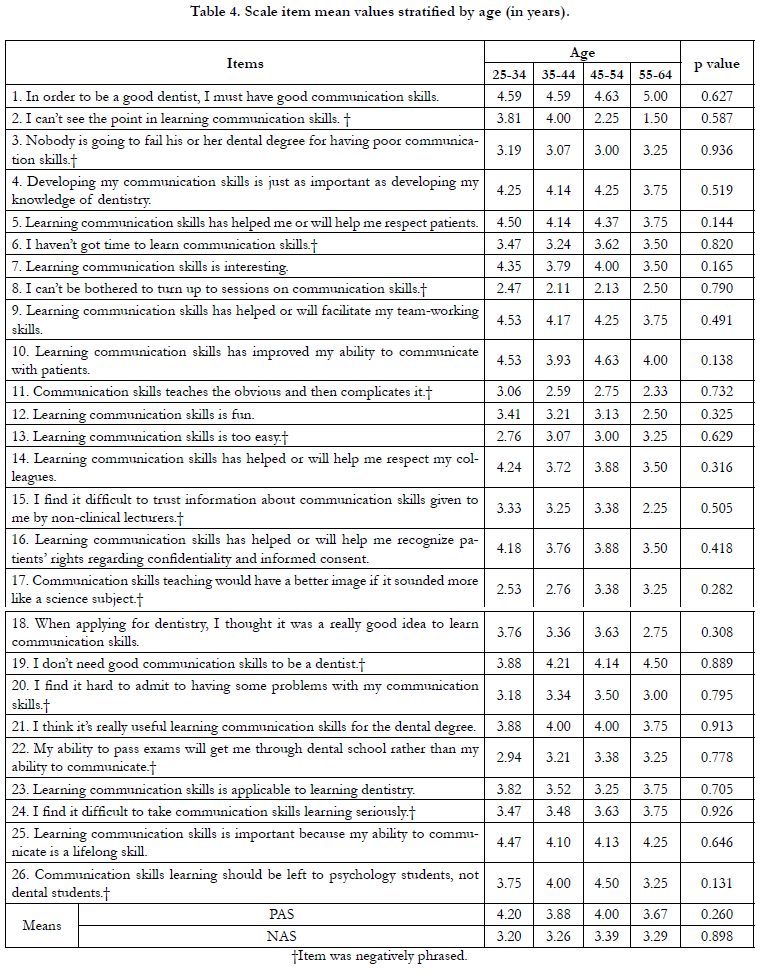Attitudes Of Dentist Towards Communication Skills Learning
Sabika Saeed H.S. Al Muraikhi1, Khalid Esmael M. E. Rahimi2, Fatima Jassim M.H Albaker3, Ashwin C Shetty4*
1 Consultant, Department of Dental Diagnostic Surgical Science, Hamad Medical Corporation, Qatar.
2 Associate Consultant, Department of Dental Diagnostic Surgical Science, Hamad Medical Corporation, Qatar.
3 Specialist, Department of Prosthodontics, Hamad Medical Corporation, Qatar.
4 Assistant Professor, Vice Deanship for Postgraduate Studies and Scientific Research, Imam Abdulrahman Bin Faisal University, Kingdom of Saudi Arabia.
*Corresponding Author
Dr. Ashwin C Shetty,
Assistant Professor, Vice Deanship for Postgraduate Studies and Scientific Research, Imam Abdulrahman Bin Faisal University, Kingdom of Saudi Arabia.
E-mail: asyermal@iau.edu.sa
Received: November 08, 2020; Accepted: December 02, 2020; Published: December 07, 2020
Citation:Sabika Saeed H.S. Al Muraikhi, Khalid Esmael M. E. Rahimi, Fatima Jassim M.H Albaker, Ashwin C Shetty. Attitudes Of Dentist Towards Communication Skills Learning. Int J Dentistry Oral Sci. 2020;7(12):1187-1192. doi: dx.doi.org/10.19070/2377-8075-20000235
Copyright: Ashwin C Shetty©2020. This is an open-access article distributed under the terms of the Creative Commons Attribution License, which permits unrestricted use, distribution and reproduction in any medium, provided the original author and source are credited.
Abstract
Background: Communication is a key component of the patient and dentist relationship.
Objectives: This study was done to determine the attitude of dentist toward learning communication skills and to recognizethe
factors influencing attitude toward learning communication skills.
Materials and Method: A cross-sectional study using a self-administered, 26-item, adapted Communication Skills Attitude Scale
(CSAS) was carried out among dentist working in a public sector hospital in Qatar. From the adapted CSAS, positive attitude score
(PAS) and negative attitude score (NAS) were determined. Obtained data was statistically analyzed using SPSS version 20 with
non-parametric tests.
Result: Fifty-nine dentists completed the survey giving an overall response rate of 53.6%. The average (SD) PAS and NAS scores
were 3.98 (SD=0.54) and 3.26 (SD=0.49) respectively. Female dentist was more positive towards learning communication skills
than male.There was no substantial association was established between both PAS and NAS scores and respondents’ age.
Conclusion: Dentists’ had both positive and negative attitudes towards learning communication skills.It is suggested to presentcommunication
skills formal training gatherings based on higher NAS scores.
2.Introduction
3.Materials and Methods
4.Results
5.Discussion
6.Conclusion
7.Refereces
Keywords
Attitudes; Communication Skills; Dentist; Learning; Patient.
Introduction
Communication is akey component of the patient and dentist
relationship. Communication between patients and healthcare
professionals is a fundamental process within the patient–clinician
relationship from the initial consultation onwards.Hence, it
is an area recognized to beof consideration during undergraduate
training for dentists [1]. Studies have reported that dental students
have positive attitudes towards learning communication skills [2,
3]. It is essential that dental schools certify that undergraduates
are effectively trained in communication skills [4].
It is important that dental students are offered with skills-based
communication training to be better prepared for clinical practice.
This will facilitate them to encounter with patient anxiety, recognize
ethical issues, and identify important psychosocial factors
leading to more precise diagnosis and treatment, thus improving
patient satisfaction and safety. It is imperative to be able to communicate
well with patients, to efficiently collect and convey information,
use effective listening skills, manage patient emotions
delicately, and express empathy, rapport, ethical consciousness,
and professionalism [5].
It has been observed that students with good communication
skills were associated with positive attitudes towards communication
skills learning and those with poor communication skills were
associated with negative attitudes towards communication skills
learning [6, 7]. Moreover, some demographic characteristics have
been determined as important in health care communication. One
such characteristics is gender which happens to impact both attitude
towards interpersonal skills and self-assessment of ability,
while females are more likely to exhibit positive attitudes towards
communication skills training than males [8].
A study on dental interns reported that females and those with
training in communication skills were associated with positive attitudes towards learning communication skills [9]. Another
study concluded that dentists, patients, and students contemplate
professional communication skills are important in the dentist–
patient relationship [10]. However, there is no evidence on the
attitudes toward communication skills learning among dentist in
Qatar. Hence, the aim of this study is to assess the attitude of
dentist toward learning communication skills, to recognize the
factors influencing attitude toward learning communication skills,
and to suggest the inclusion of appropriate communication skill
course.
Materials and Methods
Using a self-administered question, a cross-sectional study was
done on 26-item of adapted Communication Skills Attitude Scale
(CSAS) was performed amongst dentist employed in a publicly
owned hospital in Qatar. The CSAS was originally developed
for assessing medical students’ attitudes towards communication
skills learning. For dental use CSAS was modified and referred to
as the Dental Communication Skills Attitude Scale (DCSAS). Key
words were altered to “dental” or “dentistry” from “medicine”
or “medical,” and the word “doctor” was replaced by “dentist”
where appropriate.Ethics approval for the study was obtained
from the medical research center (#16071).Informed consent
was obtained from the participants. Anonymity and confidentiality
were assured.
The questionnaire was divided into two partsand administered in
English language to all dentists. Part A consisted of demographic
questions. Part B consisted of the 26-item validated DCSAS questionnaire
with two sub-scales: Positive Attitude Subscale (PAS)
and Negative Attitude Subscale (NAS). The PAS consisted of
13 items (items one, four, five, seven, nine, ten, twelve, fourteen,
sixteen, eighteen, twenty-one, twenty-three, and twenty-five) representing
positive attitudes towards communications skills learning.
The NAS consisted of 13 items (items two, three, six, eight,
eleven, thirteen, fifteen, seventeen, nineteen, twenty, twenty-two,
twenty-four, and twenty-six) representing negative attitudes towards
communication skills learning.
The 26-item questionnaire was on a five-point Likert scale ranging
from 1 (strongly agree) to 5 (strongly disagree). Overall, two
scores wereconcluded from the adapted CSAS: the average PAS
and NAS scores. They were determined by summing the scores
of the 13 PAS and 13NAS items, respectively, and dividing them
by the number of items in each scale. The scores range from 13
to 65 for both PAS and NAS. The highest average score suggests
stronger attitude.
Data was analyzed using IBM SPSS version 22.0. Univariate
analysis was performed to present the overview of the findings.
Non-parametric tests such as Spearman’s r, Mann-Whitney, and
Kruskal-Walliswere used to determine the relationships between
dependent (PAS and NAS scores) and independent (demographic)
variables. A p value of ≤ 0.05 was considered as statistically
significant.
Results
Fifty-nine dentists completed the survey out of a total of 92 dentists,
giving an overall response rate of 64.1%. Table 1 shows the
frequency distribution of demographic variables of the sample.
The median age of the dentists was 36-45 years. Most of the dentist
were female (79.3%, n=46). There was no statistically significant
association between age and gender (p>0.05).
Table 2 shows the overall mean value of the responses for each item. The mean value of the responses for each item was examined stratifying by demographic subgroups. A higher score indicates a more positive attitude towards learning communication skills. Analysis of the data on the dentists’ attitudes towards communication skills learning showed that both male and female dentists possessed positive and negative attitudes towards communication skills learning.
As for the individual items, there were statistically significant differences between males and females in the mean value of the responses for only two of the twenty-six retained survey items (p<0.05) (Table 3). Female dentists were more positive towards learning communication skills than male. Females scored higher on the PAS and males scored higher on the NAS.There were no statistically significant differences when stratified according to age group (Table 4).
The mean (SD) PAS and NAS scores were 3.98 (SD=0.54) and 3.26 (SD=0.49) respectively. Bivariate analysis was conducted to ascertain the relationships between the scores on the PAS and NAS of the dentist and their demographic characteristics. The mean PAS score was higher among females (mean=4.03, SD=0.51) compared to males (mean=3.78, SD=0.66). However, it was statistically not significant (p>0.05). The mean NAS score for the males (mean=3.34, SD=0.13) was higher than females (mean=3.24, SD=0.55) but was statistically not significant (p>0.05).
No significant correlation was found between the mean PAS score and respondents’ age (rho=-0.198, p>0.05). This suggests that as age increased, mean PAS score decreased. The mean NAS score did not correlate significantly with respondents’ age. However, the trend was not statistically significant (rho=0.035, p>0.05). This suggests that as age increased, mean NAS score increased.
Discussion
A good dentist-patient relationship comprises wide-ranging set
of skills, contemplating psychological, pharmacological, and interpersonal
and communication skills [11]. Communication with
patients is not constrained to only exchange of information, instead
involve creating, nurturing, and maintaining the doctor-patient
relationship [12]. An effective communication benefits both
patients and dentists [13]. On the contrary, poor communication
is the most common source of patient dissatisfaction [14]. This
is the first study identifying factors influencing attitude toward
learning communication skills among dentist in Qatar.
This study used an adapted CSAS for measuring dentist attitudes
towards communication skills learning. The finding of the study
showed that dentist had both positive and negative attitudes towards
communication skills learning. The mean PAS score in the
current study was in comparison to that reported in a previous
study, whereas the mean NAS score was higher [6]. The mean
PAS score of female dentists was higher than the males. The better
attitudes towards communication skills learning of female
gender are consistent with previous studies that found a similar
trend [15, 16].
Past research has shown that communication skills can be improved
through participation in basic communication skills courses
[3, 15]. There is huge support for the fact that communication
can be taught and learned [17]. There is an importance on
the necessity for teaching communication skills in dentistry and
for educational research assessing the efficiency of communication
skills-based teaching programs [5]. Hence, dental educators
oughtto pay more attention to the significance of communication
skills for the dentists.
There was a lack of statistically statistical relation between the demographics
and the PAS and NAS scores. However, the present
study had certain limitations. The scale was administered in English and dentist may have interpreted the scale in a different manner.
The response rate of the dentist may have biased the scores.
The sample size may possibly have led to type II error. Some of
the analysis, particularly factor analysis that yield multiple factors
(Learning, Importance, Quality, and Success) may produce different
results with a larger number of respondents. Future studies
should seek to increase the sample size and the power of the factor
analyses.
Conclusions
This study found that dentists had both positive and negative attitudes
towards communication skills learning. Considering the
high NAS scores, communication skills formal training sessions
should be introduced. Opportunities should be provided to learn
communication skills through training enhanced by conducting
continuing dental education and workshops. Further studies
across the nation are required to gain an insight into the problems
of communication skills training in Qatar.
Acknowledgments
We are grateful to all the dentist respondents for participating in
the study.
References
- Manogue M, Brown G, Foster H. Clinical assessment of dental students: values and practices of teachers in restorative dentistry. Med Educ. 2001 Apr;35(4):364-70. Pubmed PMID: 11319000.
- Laurence B, Bertera EM, Feimster T, Hollander R, Stroman C. Adaptation of the Communication Skills Attitude Scale (CSAS) to dental students. J Dent Educ. 2012 Dec;76(12):1629-38. Pubmed PMID: 23225682.
- White JG, Krüger C, Snyman WD. Development and implementation of communication skills in dentistry: an example from South Africa. Eur J Dent Educ. 2008 Feb;12(1):29-34. Pubmed PMID: 18257762.
- Carey JA, Madill A, Manogue M. Communications skills in dental education: a systematic research review. Eur J Dent Educ. 2010 May;14(2):69-78. doi: Pubmed PMID: 20522105.
- Hannah A, Millichamp CJ, Ayers KM. A communication skills course for undergraduate dental students. J Dent Educ. 2004 Sep;68(9):970-7.Pubmed PMID: 15342658.
- Nor NA, Yusof ZY, Shahidan MN. University of Malaya dental students' attitudes towards communication skills learning: implications for dental education. J Dent Educ. 2011 Dec;75(12):1611-9. Pubmed PMID: 22184601.
- Yashoda, R.; Puranik, M. P., Dental students' attitude toward learning communication skills in Bengaluru city, India. J Indian Assoc Public Health Dent. 2016;14 (3): 327.
- Cleland J, Foster K, Moffat M. Undergraduate students' attitudes to communication skills learning differ depending on year of study and gender. Med Teach. 2005 May;27(3):246-51. Pubmed PMID: 16011948.
- Atteya, S., Saleh SM, Essam WA. Attitudes of dental interns towards learning communication skills in Alexandria University. Alex Dent J. 2017; 42,:20-27.
- Woelber JP, Deimling D, Langenbach D, Ratka-Krüger P. The importance of teaching communication in dental education. A survey amongst dentists, students and patients. Eur J Dent Educ. 2012 Feb;16(1):e200-4. Pubmed PMID: 22251347.
- Orsini CA, Jerez OM. Establishing a good dentist-patient relationship: skills defined from the dental faculty perspective. J Dent Educ. 2014 Oct;78(10):1405-15. Pubmed PMID: 25281674.
- . Kadanakuppe S. Effective Communication and Empathy Skills in Dentistry for Better Dentist-Patient Relationships. J Dent Probl Solut. 2015;2 (3): 058-059.
- Hawken SJ. Good communication skills: benefits for doctors and patients. New Zealand Family Physician. 2005;32(3):185-9.
- Lanning SK, Ranson SL, Willett RM. Communication skills instruction utilizing interdisciplinary peer teachers: program development and student perceptions. J Dent Educ. 2008 Feb;72(2):172-82. Pubmed PMID: 18250396.
- Rees C, Sheard C. The relationship between medical students' attitudes towards communication skills learning and their demographic and educationrelated characteristics. Med Educ. 2002 Nov;36(11):1017-27. Pubmed PMID: 12406261.
- Wiskin CM, Allan TF, Skelton JR. Gender as a variable in the assessment of final year degree-level communication skills. Med Educ. 2004 Feb;38(2):129-37. Pubmed PMID: 14871383.
- Aspegren K. BEME Guide No. 2: Teaching and learning communication skills in medicine-a review with quality grading of articles. Med Teach. 1999;21(6):563-70. Pubmed PMID: 21281175.









